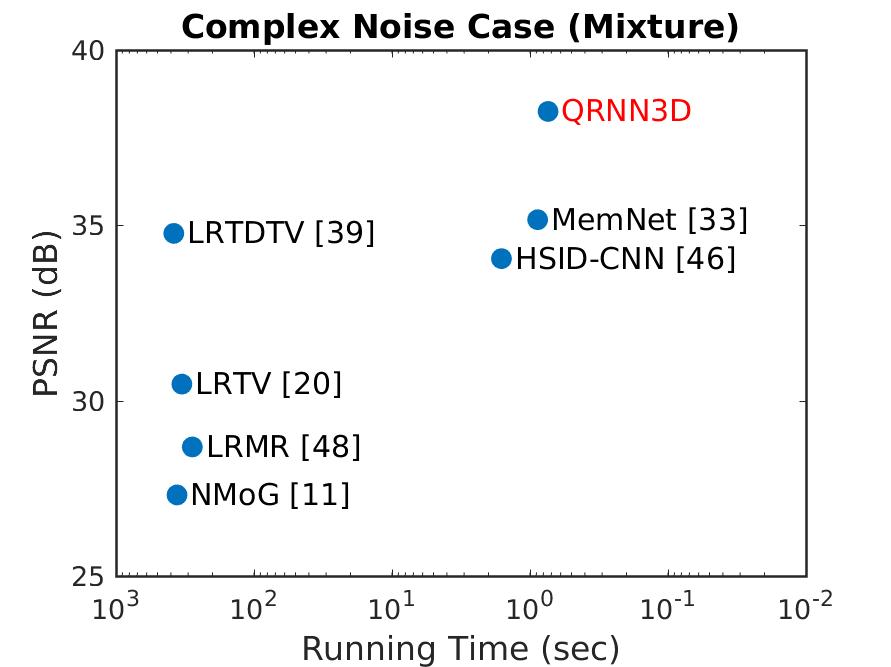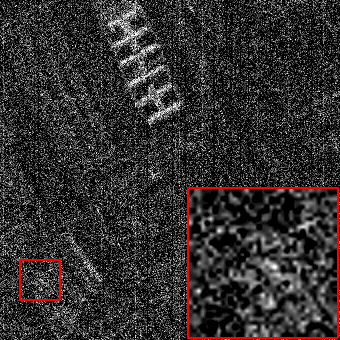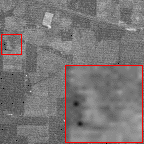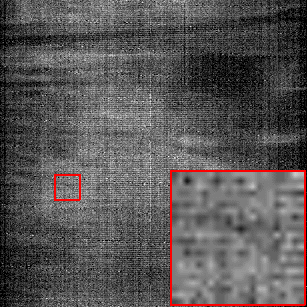The implementation of TNNLS 2020 paper "3D Quasi-Recurrent Neural Network for Hyperspectral Image Denoising"
🌟 See also the follow up works of QRNN3D:
- DPHSIR - Plug-and-play QRNN3D that solve any HSI restoration task in one model.
- HSDT - State-of-the-art HSI denoising transformer that follows up 3D paradigam of QRNN3D.
- MAN - Improved QRNN3D with significant performance improvement and less parameters.
📉 Performance: QRNN3D < DPHSIR < MAN < HSDT
- Our network outperforms all leading-edge methods (2019) on ICVL dataset in both Gaussian and complex noise cases, as shown below:
- We demonstrated our network pretrained on 31-bands natural HSI database (ICVL) can be utilized to recover remotely-sensed HSI (> 100 bands) corrupted by real-world non-Gaussian noise due to terrible atmosphere and water absorptions
- Python >=3.5, PyTorch >= 0.4.1
- Requirements: opencv-python, tensorboardX, caffe
- Platforms: Ubuntu 16.04, cuda-8.0
Download ICVL hyperspectral image database from here (we only need .mat version)
- The train-test split can be found in
ICVL_train.txtandICVL_test_*.txt. (Note we split the 101 testing data into two parts for Gaussian and complex denoising respectively.)
Note cafe (via conda install) and lmdb are required to execute the following instructions.
-
Read the function
create_icvl64_31inutility/lmdb_data.pyand follow the instruction comment to define your data/dataset address. -
Create ICVL training dataset by
python utility/lmdb_data.py
Note matlab is required to execute the following instructions.
-
Read the matlab code of
matlab/generate_dataset*to understand how we generate noisy HSIs. -
Read and modify the matlab code of
matlab/HSIData.mto generate your own testing dataset
-
Download our pretrained models from OneDrive and move them to
checkpoints/qrnn3d/gauss/andcheckpoints/qrnn3d/complex/respectively. -
[Blind Gaussian noise removal]:
python hsi_test.py -a qrnn3d -p gauss -r -rp checkpoints/qrnn3d/gauss/model_epoch_50_118454.pth -
[Mixture noise removal]:
python hsi_test.py -a qrnn3d -p complex -r -rp checkpoints/qrnn3d/complex/model_epoch_100_159904.pth
You can also use hsi_eval.py to evaluate quantitative HSI denoising performance.
-
Training a blind Gaussian model firstly by
python hsi_denoising_gauss.py -a qrnn3d -p gauss --dataroot (your own dataroot) -
Using the pretrained Gaussian model as initialization to train a complex model:
python hsi_denoising_complex.py -a qrnn3d -p complex --dataroot (your own dataroot) -r -rp checkpoints/qrnn3d/gauss/model_epoch_50_118454.pth --no-ropt
If you find this work useful for your research, please cite:
@article{wei2020QRNN3D,
title={3-D Quasi-Recurrent Neural Network for Hyperspectral Image Denoising},
author={Wei, Kaixuan and Fu, Ying and Huang, Hua},
journal={IEEE Transactions on Neural Networks and Learning Systems},
year={2020},
publisher={IEEE}
}and follow up works
@article{lai2022dphsir,
title = {Deep plug-and-play prior for hyperspectral image restoration},
journal = {Neurocomputing},
volume = {481},
pages = {281-293},
year = {2022},
issn = {0925-2312},
doi = {https://doi.org/10.1016/j.neucom.2022.01.057},
author = {Zeqiang Lai and Kaixuan Wei and Ying Fu},
}
@inproceedings{lai2023hsdt,
author = {Lai, Zeqiang and Chenggang, Yan and Fu, Ying},
title = {Hybrid Spectral Denoising Transformer with Guided Attention},
booktitle={Proceedings of the IEEE International Conference on Computer Vision},
year = {2023},
}
@article{lai2023mixed,
title={Mixed Attention Network for Hyperspectral Image Denoising},
author={Lai, Zeqiang and Fu, Ying},
journal={arXiv preprint arXiv:2301.11525},
year={2023}
}Please contact me if there is any question (kxwei@princeton.edu kaixuan_wei@bit.edu.cn)




